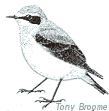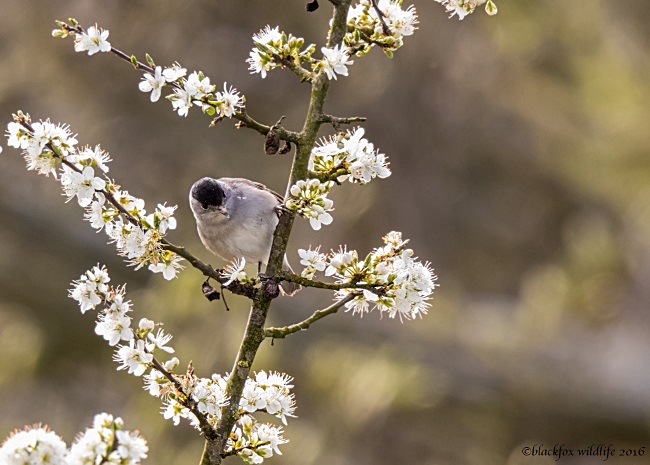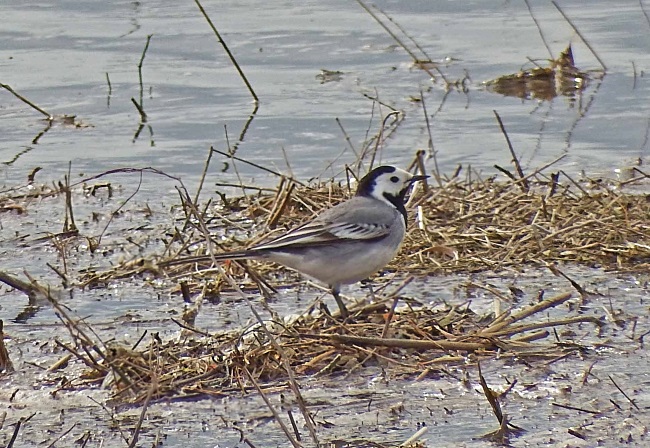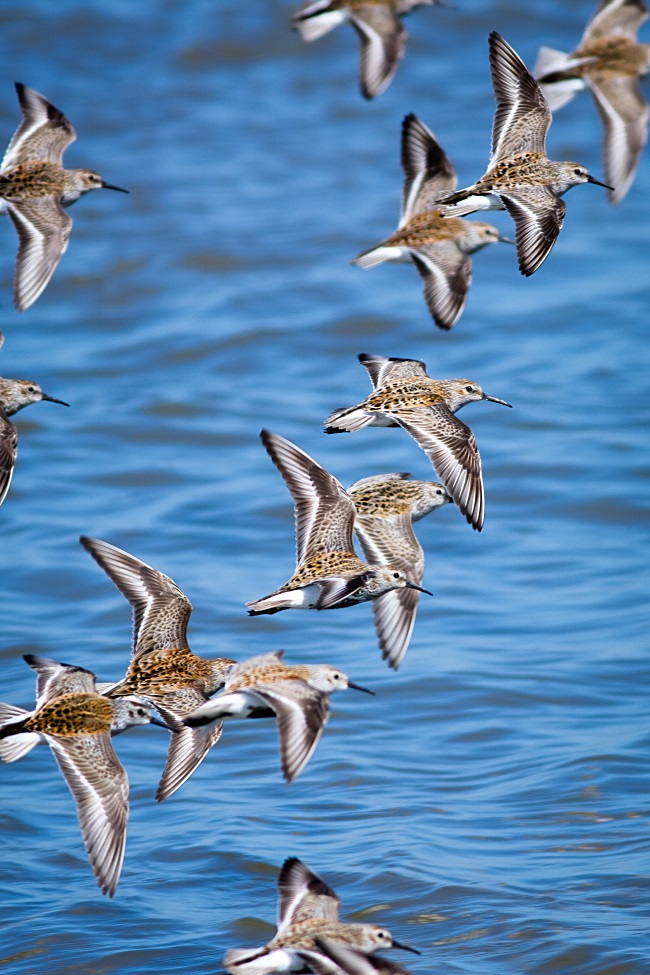Site menu:

May 2016 Newsletter
Rights and Wrongs.
April Bird News.
Forthcoming Events.
Latest Newsletter.
Rights and Wrongs

"People have the right to
do whatever they want on the beach!!"
said the rather aggressive man. A nonsensical statement of course, but
I
realised what he meant which was that people had the right to walk on
the beach without being bawled at by some mad birdwatcher (i.e. me).
It was my own fault, we are told as Voluntary Wardens always
to
quietly approach people, explain about the birds and politely ask them
if they wouldn't mind stopping their dog chasing the birds or could
they possibly walk in a slightly different direction in order to avoid
disturbing the wader roost. Instead I had shouted at a woman, who was
allowing her two large dogs to chase a flock of Knot, from 100 yards
away. Sometimes shouting is the only way to stop disturbance
but
it does get peoples' backs up so is not normally recommended. The man
who talked to me, ranting about peoples' 'rights', had nothing to do
with the woman, and was just a busybody, but he did get me thinking
about exactly what 'rights' people really have on a highly protected
site like the Dee estuary; especially in relation to letting dogs chase
birds and the many other recreational activities, such as Kite Surfing,
which results in birds being severely disturbed.
Protection on the Dee Estuary
The Dee Estuary and North Wirral coast is protected by the following designations:(a) Ramsar Site under International
Treaty.
(b) Special Protection Area (SPA) under the European Union Birds and
Habitats
Directives.
(c) Special Area of Conservation (SAC) under the European Union
Habitats Directive.
(d) Site of Special Scientific Interest (SSSI) under UK law.
"SPAs are intended to safeguard the habitats of the species for which they are selected and to protect the birds from significant disturbance."
There have been many acts of Parliament transposing the above treaties and directives into UK law including 'The Countryside and Rights of Way Act 2000' which created an arrestable offence of reckless disturbance.
There is much about SSSIs and the Royal
Photographic
Society neatly summarises this:
"anyone who intentionally or recklessly destroys or damages any of the
flora, fauna, geological or physio-graphical features by reason of
which a site is of special interest, or intentionally
or recklessly disturbs any of those fauna, is guilty of an
offence and is liable on summary conviction to a fine."
Natural England
have a six page document entitled "SSSI enforcement policy statement"
which you can download from their website. They, in conjunction with
the police, are responsible for enforcing the law, e.g. "we
can take appropriate enforcement action when the law is broken and when
the habitat and features of SSSIs are damaged, disturbed or
destroyed" and "Types of offence (any person): Intentionally or
recklessly damaging, destroying or disturbing
any of the habitats or features of an SSSI".
Further Thoughts
I think we can safely say people do NOT have a 'right' to let their dogs chase birds on the shores of the Dee estuary and North Wirral (or, indeed, any other similar site), nor do they have a 'right' to disturb birds through the many other activities which people partake in besides and on the estuary.
Prosecutions are very much a last resort and only happen in extreme circumstances. Natural England make a point of saying they only take people to court if they are certain of getting a conviction and where costs can be recovered. So prosecutions are very rare, and it's always far better to try and prevent disturbance in the first place by education through such means as wardening, notice boards, leaflets and the media (for example see this article in The Globe).
Wirral Borough Council own most of the shore from Heswall right round to New Brighton, and it is this area which is the most heavily used for recreational purposes. WBC do support the Dee Estuary Voluntary Wardening scheme at West Kirby, but away from West Kirby there is much disturbance, most worringly at the important high tide roost at Hoylake. Interestingly, I understand that Natural England have recently asked WBC to reduce this disturbance and I know somebody has been monitoring the causes of disturbance through the winter. So it will be interesting to see if anything comes out of that.

I've made a point
of mentioning dogs and their owners as causes of disturbance
as there are so many of them, but there are plenty of other problem
activities. The photo shows a powered para glider at West Kirby landing
on the shore full of gulls and terns. As well as recklessly disturbing
the birds they are a danger to themselves and the general public, and
they are also breaking all manner of CAA regulations. As
well as trying to stop these WBC need also to be more active in
regulating Kite Surfing at West Kirby, Red Rocks and Hoylake, and Para
Gliding at Thurstaston, both of which cause havoc among roosting and
feeding waders particularly during the winter months.
At the end of the day is it really too much to ask people to respect the wildlife of a beautiful wilderness such as the Dee Estuary?
References/Further Reading:
1. Ramsar Convention, http://www.ramsar.org/.
2. Special
Protection Areas (Scottish Government Website)
-
http://www.gov.scot/Topics/marine/science/MSInteractive/Themes/SpecialProtectedAreas
2.
Birds Directive, JNCC website: http://jncc.defra.gov.uk/page-1373.
4. The Countryside and Rights of Way Act 2000. JNCC website: http://jncc.defra.gov.uk/page-1378.
5. Natural England: SSSI enforcement policy statement.
6. Dee Estuary Voluntary Wardens - please contact the Rangers at Thurstaston Visitor Centre if you wish to join or require further information (0151 648 4371).
PLEASE NOTE: My research for the above article mainly involved 'Googling' the relevant web pages and I have quoted from official web sites as much as possible. I also have had some experience, as secretary of the Dee Estuary Conservation Group for several years, in such matters as Ramsar sites, SPAs and various disturbance issues, and much experience being a Voluntary Warden for three different schemes at Gronant, Point of Ayr and West Kirby. Nevertheless, I take full responsibility for any of my own misunderstandings, perhaps getting things plain wrong or missing out of important information. I am NOT an expert on Wildlife Law!
Richard Smith
Top of PageApril Bird News
Last month I wrote about a high
pressure system
holding up the migration due to cold north winds, in April it was a low
pressure system also resulting in cold north winds which effectively
killed any northwards movement in the last 10 days of the
month.
The table shows that the first arrivals of every one of the species
listed was later than 2015.
| Species | 2016 | Location | 2015 | 2014 |
|---|---|---|---|---|
| White Wagtail | 15th March | Hilbre | 10th March | 8th March |
| Sand Martin | 16th March | Neston | 7th March | 20th March |
| Wheatear | 23rd March | Meols | 11th March | 10th March |
| Swallow | 24th March | Shotton | 20th March | 19th March |
| Willow Warbler | 29th March | Leasowe
and Thurstaston |
22nd March | 12th March |
| House Martin | 7th April | Parkgate | 31st March | 29th March |
| Whitethroat | 13th April | Burton | 12th April | 4th April |
| Cuckoo | 21st April | Leasowe | 20th April | 2nd May |
| Swift | 22nd April | Burton | 19th April | 3rd May |
Nevertheless, before the north winds set in we had some good numbers, particularly of Wheatears with over 100 in the Leasowe Lighthouse area on the 4th, 57 on Hilbre on the 12th and at least 50 at Red Rocks on the 21st. We had a toal of 25 Ring Ouzel records and 24 Redstart records, not quite as good as 2015 with 31 and 37 respectively. Although the White Wagtail passage was slow on Wirral there was an excellent count of at least 110 on Gronant beach on the 21st.

We had some good high tides which covered the
marsh off Heswall and Parkgate resulting in excellent views of at least
four Short-eared Owls on the 8th off Heswall Golf Course, with
three there the next day. But the most interesting event as
far
as I was concerned was seeing the over-wintering flock of Pink-footed
Geese, probably around 4,000 strong at that time, leaving the Dee
marshes on the 9th at the start of their migration back to Iceland.
They left in many flocks, some several hundred strong, from dawn to
high tide, i.e. from 7.30am to 1pm. Many passed over my house in Caldy
and were seen from Hilbre and all along North Wirral. I was at Heswall
when a total of at least a thousand took off from the marshes as the
tide came in. It was certainly a mass exodus, just awesome.
There were some periods of westerly winds which resulted in some good sea watching including 65 Gannets on the 4th and 115 Little Gulls on the 16th, plus Arctic Skuas, Arctic Terns, Common Terns, Little Terns and Sandwich Terns. But March's huge flocks of Common Scoters never reappeared presumably moving elsewhere.

As usual Heswall shore was the best place to see Whimbrels with max of
56 on the 22nd and 62 on the 23rd. There were a couple of records of
Curlew Sandpipers at Heswall with at least two on the 13th and a single
on the 14th, plus one at Hilbre on the 24th.
April records of Curlew Sandpipers are very unusual, the only one I can
find over the past five years is a summer plumaged bird at Hilbre on
April 26th 2015.

Six Ospreys flew over, all in the first half of the month. At least one
ringtail Hen Harrier was recorded many times but just three records of
a single Marsh Harrier. Rarities included two sightings of an Iceland
Gull on East Hoyle Bank, two Common Cranes flew over Burton Mere
Wetlands on the 11th and over Red Rocks on the 13th, and a Hooded Crow
flew over Leasowe Lighthouse on
the 30th.
 Summer plumaged Dunlins by Leasowe Lighthouse, April 20th ©
Benjamin Twist.
Summer plumaged Dunlins by Leasowe Lighthouse, April 20th ©
Benjamin Twist.
What to expect in May
Some birds, mainly young ones, overshoot their normal breeding area and this can result in some good rarities turning up; in the past few years we've had Black-winged Pratincole, Bluethroat, Golden Oriole, Nightingale and Red-rumped Swallow.
Over the past couple of years we've had a really good passage of Dunlin with up to 15,000 at Hoylake, along with Ringed Plovers and Sanderlings. Look at these birds with awe as some will have flown all the way from South Africa and are heading for the high Arctic to breed. Also look out for summer plumaged waders with Bar-tailed Godwits and Grey Plovers looking gorgeous in their breeding finery. Among these waders may well be some rarities with Broad-billed Sandpiper, Dotterels and Teminck's Stint all seen over the past few years.

Top of Page
Forthcoming Events
May Highest Spring Tides (Liverpool)
Also
see Tides
page.
6th May, 11.24hrs (BST), 9.8m.
7th May, 12.12hrs (BST), 10.0m.
8th May, 12.59hrs (BST), 10.0m.
Forthcoming Events
Organised by the Wirral
Ranger Service , Flintshire
Countryside Service and the
RSPB (Dee Estuary):
All these events and walks have bird interest, even those not
advertised specifically for birdwatching. No need to book for these
events unless specified - please check below.
1pm to 3pm (approx finish)
Price: Free (normal reserve entry charges apply to non-members).
Join one of our friendly, knowledgeable volunteers for a gentle walk from the Reception Hide to the end of the Hillfort Trail on Burton Point, to learn more about the wildlife that thrives here, the work we do to give nature a home and the remarkable history of the estuary.
Great for first time visitors or those who'd like a guide to help them get the most enjoyment from a visit. With constant changes as we move through the seasons, it's impossible to predict what might be seen but nesting wading birds, herons and ducks are guaranteed, with an array of colourful flowers, butterflies and dragonflies emerging into the warmer months, there's always something to marvel.
No booking required, just turn up on the day. A reasonable level of fitness and sturdy footwear are required. Ring 0151 353 8478 for further details.